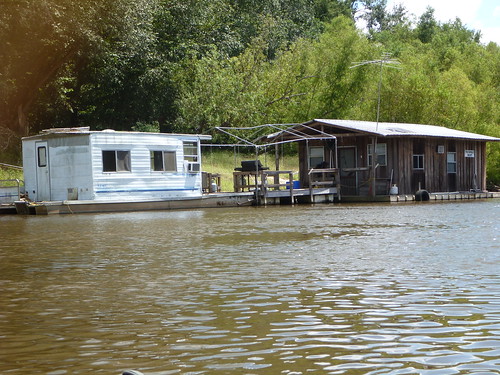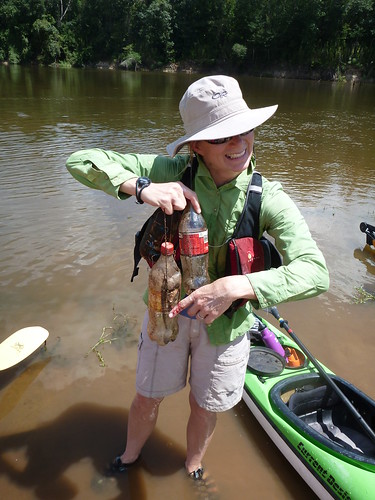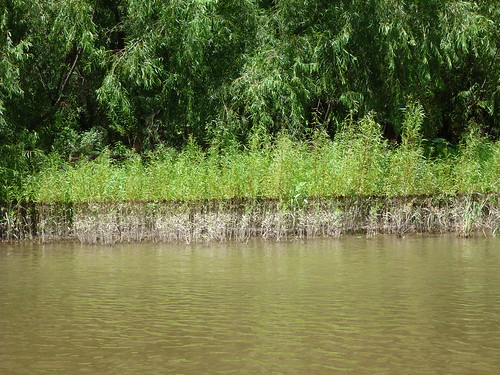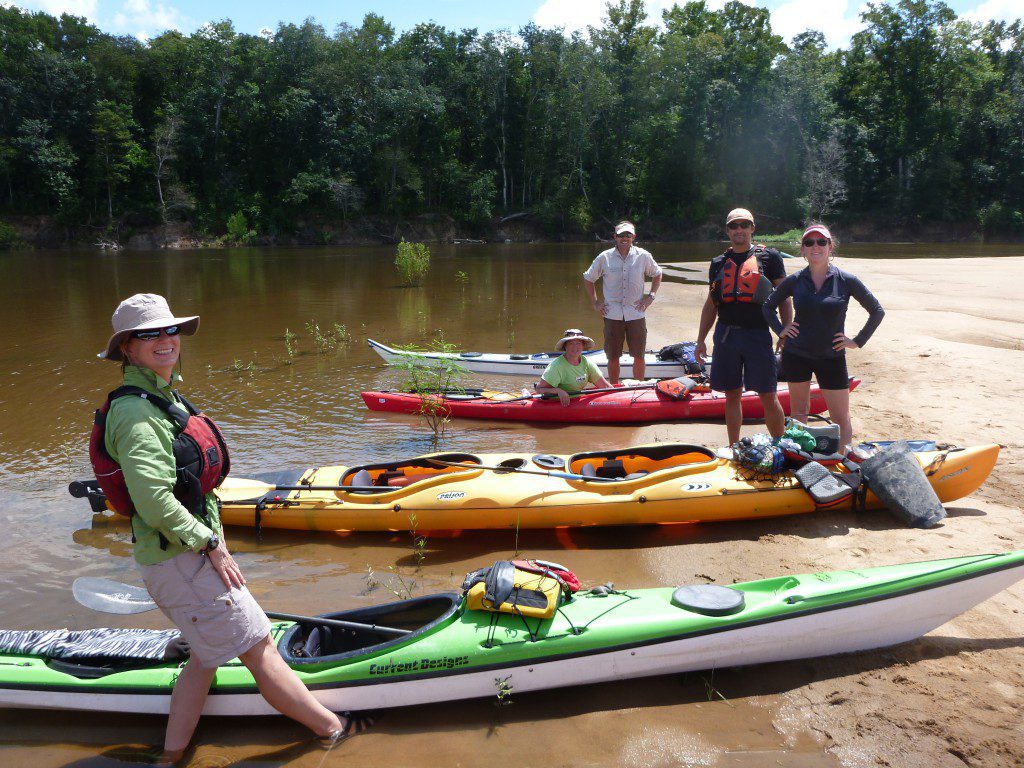Rob Diaz de Villegas WFSU-TV
If you’re an oyster lover, this photo might concern you. This was taken yesterday on a long paddle along the Apalachicola River. Participants in this year’s Rivertrek fundraiser (click here for the website) were taking an eighteen mile warm up paddle in preparation for the five day adventure this October. Then, we’ll be tackling the entirety of the River. I snapped this photo about an hour after our lunch break, during the long part of our trip where I learned why stretching before paddling is so important.
For us, on this blog, it’s a matter of salinity. According to the National Oceanic and Atmospheric Administration, the average salinity of the ocean is 35 parts per thousand (ppt). That’s 35 grams of salt dissolved in every thousand grams of water. Oysters, like those in the famous Apalachicola Bay, can survive within a wide range of 5 ppt to 40 ppt. Yet they thrive predominantly in fresher water. Why is that? It has to do with the organisms that affect the health of an oyster. Oyster drills and stone crabs, both oyster consumers, cannot survive in less than 15 ppt salinity. The oyster disease Dermo (Perkinsus marinus) thrives in 21-25 ppt. That’s why successful reefs are typically found where a fresh water source meets the ocean, like where the Apalachicola River flows into Apalachicola Bay. It’s also why that photo can be of concern: it marks the decrease in fresh water flowing along the Apalachicola and into the Bay (the line marks where water flow had been). That decrease in flow has been a result of drought, but it serves as a reminder of the greater threat facing the River basin: the management of water north of the Woodruff Dam, and the amount let through to the river..

Houseboats and fishing/ hunting shacks were scattered along the river. The sign on this one identified it as “The Redneck Yacht.”
This year will be the fourth year that the Rivertrek fundraiser will benefit the Apalachicola Riverkeeper, who fight to keep water flowing at levels that benefit the dependent industries in the Bay and one of the most biodiverse areas in the United States. This year, In the Grass, On the Reef will be along to provide daily snapshots of the journey. From October 10 to October 14, we’ll have images of the trip and stories of each day’s trek. Yesterday’s tuneup allowed me to experiment with how I wanted to shoot from a kayak using our waterproof cameras. The image looks best when I get closer; the trick is not hitting the subject of my shot, whether it’s a cypress tree or another kayaker. I also saw how best I could arrange my gear so that I could get my work done while paddling comfortably. And I also got to know some of my fellow Trekkers.
 I had already known Georgia Ackerman and Rick Zelznak, owners of the Wilderness Way. I will disclose that The Wilderness Way has been a WFSU underwriter, and had provided kayaks to the In the Grass, On the Reef project early on (Riverkeeper has also underwritten WFSU). They provided us our kayaks yesterday as well, and will provide some for the Rivertrek paddle (including mine). Georgia, ever passionate about our water ways, picked up trash along the river and ended up taking a fish hook to her finger. Luckily, we were paddling with an ER nurse.
I had already known Georgia Ackerman and Rick Zelznak, owners of the Wilderness Way. I will disclose that The Wilderness Way has been a WFSU underwriter, and had provided kayaks to the In the Grass, On the Reef project early on (Riverkeeper has also underwritten WFSU). They provided us our kayaks yesterday as well, and will provide some for the Rivertrek paddle (including mine). Georgia, ever passionate about our water ways, picked up trash along the river and ended up taking a fish hook to her finger. Luckily, we were paddling with an ER nurse.
Eddie Lueken will be one of our crucial support crew during the trek, driving back and forth to bring us supplies and food. One night, she’ll be making us machaca, a tasty sounding Mexican beef dish (with an accompanying bean dish for the vegetarian paddlers). An Emergency Room nurse with a knack for story telling, she had us in stitches (no pun intended) with some of her stories.
Paddling together in a tandem kayak were Jennifer Portman and Chris Robertson. Jennifer is the other media member taking part in the Trek; she writes for the Tallahassee Democrat. Chris will be one of the fundraisers- everyone on the trip except Jennifer and I have to get pledges. He came with several detailed laminated maps of the river. They were formidable in their tandem, often well ahead of us and scouting for the entrance to Owl Creek, where we ended our trip. They, Eddie, Georgia, and Rick were great people to paddle with. The River and its struggles are always a big story in our area, and I’m happy to document a part of that story. The opportunity to get footage along all the different parts of the River is priceless. The River basin has to be considered the ecological epicenter of this area.
Halfway through yesterday’s paddle, we started smelling salt. The River provides for the Bay, but the Bay gives a little to the River, too. Many of the fish that make use of the oyster reefs and seagrass beds in Apalachicola Bay come up the river. Rick even saw a blue crab swimming at one point, over twenty miles up the River. Next week’s video explores the real value of the oyster reef, and how its influence can be felt beyond our coasts. If you haven’t seen the first in our second series of videos, it sets up the commercial importance of the intertidal ecosystems such as those that found in and around Apalachicola Bay. You can watch it here.
Below is a slideshow of our trip, from the River Styx to Owl Creek:
In the Grass, On the Reef is funded by a grant from the National Science Foundation.



3 comments
Rob, while I commend your work, and your coverage, it may be too late. I, and other OSPREY volunteers attempted to document salinity killing freshwater aquatic vegetation upriver as far as Saul’s Creek in June of 2011. We could not get any response from people in the community, including the Riverkeeper. The Board of County Commissioners for Franklin County met this morning in a standing room only courthouse meeting and declared a State of Emergency for the County because of the rapidly deteriorating seafood productivity of the Apalachicola Bay. The winter oyster bars opened this past weekend, and the consensus is unanimous from all quarters: there are no legal sized oysters to catch on the winter bars, and no oyster spat to be found in the Bay. But the alarm extends to other catches as well: no bay shrimp for nearly two years; extremely reduced blue crab catch; recreational species flagging as well, and few pogies and other types of bait fishes. Whatever the underlying causal factors, the results, long recognized by those that must make a living from the water, have suddenly become undeniable by those who previously chose to ignore them in the past. I pray that while some here “Fiddled”, this “Last Great Bay” has not been allowed to teeter past the tipping point of no return, as the Chesapeake was allowed to do. All the fresh water in the world will not help if no wild, native seed oysters survive to make spat for the future. God help us all.
An emergency meeting was held yesterday 9/6 with many state officials in attendance, as well as 450 to 500 local bay workers and citizens. Here is a link to a video: http://youtu.be/nqeKr2quRHk Things are looking up!
[…] that’s what I get for making her pose with a bloody finger and the hook that got her and then posting it here a couple of months ago. No blood though, it just snagged my […]
Comments are closed.